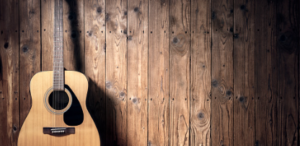An acoustic guitar is a string instrument that uses resonance to create sound. It uses steel strings and is used in a variety of musical genres.
The fingerboard has marks, called frets, indicating where to press the strings with your left hand, changing the notes they play. Guitars can also use magnetic pickups to enhance the sound produced by the guitar.
Sound
The guitar is a stringed musical instrument that has been played for millennia. It consists of a fretted body with a flat wooden soundboard and is played by strumming the strings with one hand while pressing the fingers of the other hand against the frets to play individual notes or chords. It may be amplified electrically or acoustically with a guitar amplifier. It is a member of the chordophone family and descends from several instruments, including the vihuela and lute, that are documented in artworks dating back to ancient times.
The most crucial element of a Studio1 acoustic guitar is its top, which determines tone quality by vibrating and projecting the sounds produced by the strings into the body. The top is usually made from high-quality woods such as spruce or red cedar, and different types of internal bracing strengthen it. The back and sides of the guitar body also contribute to tone.
 Acoustic guitars are available in various shapes, sizes, and styles, with dreadnaught models being the most popular among contemporary performers. Some acoustic guitars have steel strings, which create a brighter sound that projects at higher volumes. Others have nylon strings, which produce a warm, rounded sound that blends well with most genres of music and lends itself to finger-picking melodies.
Acoustic guitars are available in various shapes, sizes, and styles, with dreadnaught models being the most popular among contemporary performers. Some acoustic guitars have steel strings, which create a brighter sound that projects at higher volumes. Others have nylon strings, which produce a warm, rounded sound that blends well with most genres of music and lends itself to finger-picking melodies.
A wide range of woods can be used to build acoustic guitar bodies, although most are made from hardwoods like maple or mahogany. Other materials include carbon composites, plastic material, and aluminium alloys. Some have a piezoelectric pickup installed, which makes them self-acoustical and allows the player to hear themselves playing without an amp or speaker.
The nut is a small strip of bone, brass, corian, or other medium-hard material that rests at the headstock end of the guitar neck and is fitted with grooves that guide the strings as they are played. It is a critical component of the guitar’s structural integrity and is often customized by players to suit their personal playing style and tuning preferences. A nut can affect string tension and the ability of the strings to retain their pitches, so it must be properly cut and fit.
Look
Acoustic guitars come in a variety of shapes, sizes, and colours. However, acoustic and electric can be grouped into two broad categories. The type of guitar you choose depends on the music you want to play, whether in a band or solo folk-style songs. It would be best to consider whether you wish to use the guitar with an amp or prefer the sound of a hollow wood body that amplifies natural resonance.
The primary Studio1 acoustic guitar has six strings, a neck, and a sound hole at the end. When a string is plucked, it vibrates the body’s wood, transmitting that vibration to the air inside the guitar and resonating the strings’ harmonics. The timbre of those overtones is what distinguishes one guitar from another.
A good quality acoustic guitar will have a soundboard made of a resonant material like spruce. It makes the sound produced by the strings full and rich. The acoustic guitar’s size and shape will also impact its sound. For example, a giant guitar has a brassier, fuller sound than a smaller one.
Some acoustic guitars are decorated with unique finishes that add to the instrument’s look. For example, some have abalone, a complex, shiny interior lining of a sea snail’s shell used for inlays on the fretboard and headstock. Other finishes include rosewood, ebony, and maple. The grain of a piece of wood is also essential when it comes to the way it sounds. Figured woods, such as curly maple and ebony, have patterns of lines in the grain that contribute to the guitar’s tone.
If you’re unsure what kind of acoustic guitar you need, list artists you like and research what type of guitar they play. Then, choose a guitar with a similar body style to theirs. It will ensure that you have an acoustic guitar that is well-suited to the genre of music you’re going to play. You can also opt for a semi-acoustic acoustic guitar with a built-in pickup system.
Feel
An important factor for beginners is the feel of the guitar. It means how well it fits in the hand, how easy it is to play and how comfortable it is to hold over long periods. A Studio1 acoustic guitar should feel like a natural extension of your arm and shouldn’t be too heavy or unwieldy. A good guitar will have a comfortable neck profile (C, D or V), and the action should be low so it’s easy to fret and bend strings.